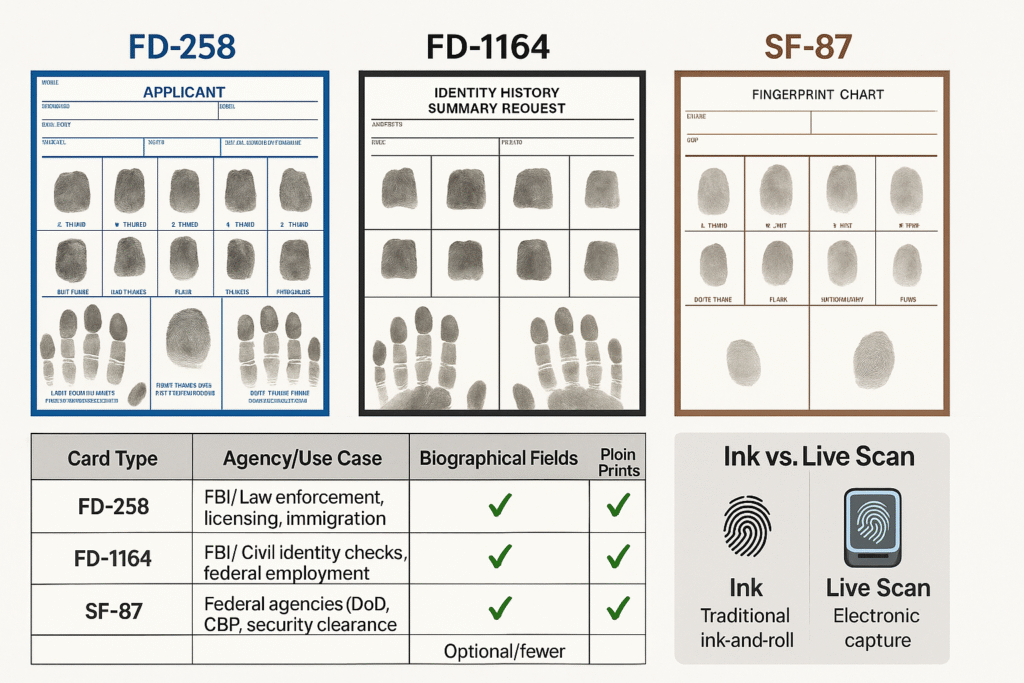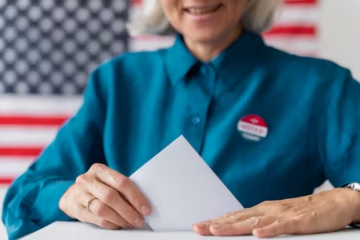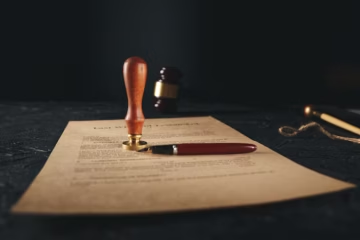Comparing Fingerprint Cards: FD-258, FD-1164, and SF-87
Applicants frequently inquire about fingerprint cards, which are a vital component of background checks, professional licensing—particularly for individuals applying from out of state—and federal employment applications. Although the process for collecting fingerprints remains consistent across the primary card types, it is essential to understand the difference between FD-258 vs FD-1164 vs SF-87 fingerprint cards key differences to ensure the submission of the appropriate documentation for one’s specific requirements.
What Is a Fingerprint Card?
A fingerprint card is a standardized form used to capture and record an individual’s fingerprints. These cards are necessary for several purposes, including:
- State and federal background checks
- Out-of-state professional licensing
- Federal employment and security clearances
- Immigration and naturalization processes
- Interactions with foreign (non-U.S.) governments
Learn more about our fingerprint card services on our Fingerprint Cards page.
All 10 Fingers Must Be Fingerprinted
All applicants are required to provide fingerprints from all ten fingers using the appropriate cards. This includes two types of fingerprints:
- Rolled fingerprints**: Each finger is rolled from nail to nail (or “edge to edge”) to capture a complete print.
- Flat (plain) fingerprints**: All fingers are pressed straight down, typically grouped in sets of four fingers, along with both thumbs.
The rolled print captures data about the friction ridges, while flat prints are used to compare against the roll and verify the correct finger.
This requirement ensures comprehensive identification and adheres to the universal standards for FD-258, FD-1164, and SF-87 cards.
Key Differences Between FD-258, FD-1164, and SF-87
| Card Type | Primary Use | Issuing Agency | Typical Applications | Size & Format |
|---|---|---|---|---|
| FD-258 | Standard applicant fingerprinting | FBI | Employment, licensing, firearms, background checks | 8″ x 8″, blue & white |
| FD-1164 | FBI background checks | FBI | Identity history summary checks, federal employment, security clearance | 8″ x 8″, white |
| SF-87 | Federal employment & clearance | U.S. Office of Personnel Management (OPM) | Federal jobs, military, security clearances | 8″ x 8″, white |
What’s the Same?
- Fingerprint Requirements: All three cards require rolled and flat impressions of all ten fingers.
- Standard Size: 8″ x 8″ format ensures compatibility with agency processing and machine scanning.
- Ink or Digital Capture: Prints can be captured with ink or digitally and then printed onto the card.
What’s Different?
- Metadata and Layout: The main differences are in the information fields and formatting:
- Personal details (name, DOB, address)
- Agency/employer information
- Reason for fingerprinting
- Originating Agency Identifier (ORI) numbers
- Social Security Number or other identifiers
- Design and Branding:
- FD-258: Blue and white, standard FBI design.
- FD-1164: White, used for specific FBI checks.
- SF-87: White, with fields tailored for federal employment and security clearance.
- Intended Use:
- FD-258: Most common for employment, licensing, and general background checks.
- FD-1164: Used for FBI Identity History Summary checks and some federal jobs.
- SF-87: Required for federal employment, military, and security clearance applications.
When to Use Each Card
- FD-258: This form is generally required for most out-of-state licensure, employment, and comprehensive background checks. See FBI official FD-258 form PDF. For further information regarding our process, please refer to the Fingerprint Cards page.
- FD-1164: This form is specifically mandated for FBI Identity History Summary checks or for particular federal purposes. Additional information pertaining to FBI checks can be found on the FBI Identity History Summary Checks page.
- SF-87: This form should be utilized when applying for federal employment, military positions, or security clearances, particularly if it is stipulated by the requesting agency. See official GSA resource. Official information is also available through the U.S. Office of Personnel Management.
Tips for Submitting Fingerprint Cards
- Always verify with the requesting agency the specific card that is required.
- Ensure that all personal and agency information is completed accurately.
- Utilize only authorized fingerprinting providers; please consult our Notary and Fingerprinting Services for guidance.
- Provide the correct number of cards if multiple copies are necessary.
- Adhere to any specific instructions concerning ink color, form version, or submission method. Remember, fingerprinting is both a science and an art, and needs to be done with care, precision, and attention to detail in order to ensure that one’s prints are successfully submitted.
Summary Table
| Card Type | Fingerprint Data | Metadata/Fields | Typical Use |
|---|---|---|---|
| FD-258 | Rolled & flat (all 10 fingers) | Standard FBI, applicant info | Employment, licensing, background checks |
| FD-1164 | Rolled & flat (all 10 fingers) | FBI applicant, more federal fields | FBI background checks, federal jobs |
| SF-87 | Rolled & flat (all 10 fingers) | Federal employment, security fields | Federal/military employment, clearances |
In summary:
The principal distinction among the FD-258, FD-1164, and SF-87 fingerprint cards resides in their metadata and layout, rather than in the fingerprinting process itself. Each card necessitates fingerprints from all ten digits; however, they capture varying information and serve distinct purposes for different agencies. It is important to consult with the requesting authority to ensure that the appropriate form is utilized for your application. It’s also important to emphasize that while one must make absolutely sure that the correct metadata information is entered in the card, the quality of the fingerprint itself is the most important element; metadata can always be corrected, but a fingerprint with poor quality cannot.

Side-by-side infographic showing fingerprint card types used by the FBI and federal agencies, with comparison of biographical fields, fingerprint sections, and submission methods.
Frequently Asked Questions About Fingerprint Cards
What is the difference between FD-258, FD-1164, and SF-87 fingerprint cards?
The main difference is in the metadata and layout of the cards, such as the fields for personal and agency information. All three require fingerprints from all ten fingers, but each is designed for specific uses: FD-258 for general employment and licensing, FD-1164 for FBI background checks, and SF-87 for federal employment and security clearances.
Do all fingerprint cards require fingerprints from all ten fingers?
Yes, FD-258, FD-1164, and SF-87 cards all require rolled and flat impressions of all ten fingers to meet identification standards for background checks and licensing.
Can I use any fingerprint card for my application?
No. You should use the card type specified by the requesting agency. Using the wrong card may result in processing delays or rejection of your application.
Are ink and digital fingerprints both accepted on these cards?
Yes, fingerprints can be captured using ink or digital methods and then printed onto the appropriate card, as long as the prints are clear and meet agency standards.
Where can I get fingerprinted for out-of-state licensure or federal employment?
You can schedule an appointment with our experienced team at Anshin Notary for professional fingerprinting services. We provide FD-258, FD-1164, and SF-87 cards for a variety of licensing and employment needs.
How do I know which fingerprint card I need?
The agency requesting your background check or licensure will specify which card to use. If you are unsure, contact them or consult our Fingerprint Cards page for guidance.
Are these cards accepted nationwide?
Yes, FD-258, FD-1164, and SF-87 cards are standardized and accepted by agencies throughout the United States for their respective purposes.
Can I reuse a fingerprint card for multiple applications?
No, each application typically requires a new, original fingerprint card. Reusing cards can lead to rejection by the requesting agency. Also, never use white-out or a similar method to cover up a print with poor quality — this will almost always cause problems with the quality of the new print and may lead to rejection.


